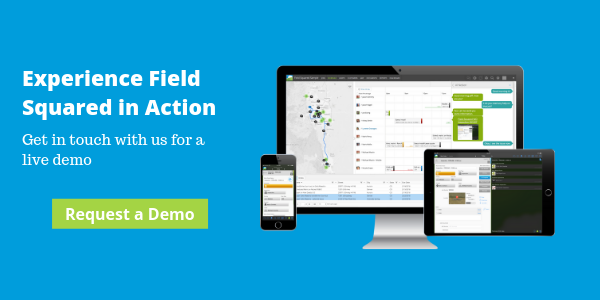
In the digital era, where technology acronyms and buzz words form headlines across the spectrum, we frequently get asked what a field service management automation platform is. We thought it’s only natural to spend some time educating the market in a blog post. So, grab a snack and settle in for a fun read.
To answer the question, what is a field service management automation platform, one first must understand what a platform is.
There are a number of field service management solutions on the market (shameless plug, Field Squared falls into this category, while also being included a month mobile workforce management and enterprise asset management software). However, looks (and marketing materials) may not be telling the whole story.
In the most basic terms, a platform must meet three criteria:
1. Extensible via interoperability with third-party systems through the use of integrations (i.e., API, web services, SFTP)
2. The ability to build custom or in-house applications on top of the underlying software
3. Configurability across a deep, broad range of industries as well as use cases
Field Service Management Platform Criteria #1: Extensible Across Back-Office/Third-Party Solutions and Systems
Typically, a field service software platform meets the extensible criteria if it has the ability to integrate to back-office/third-party systems and tools via API, FTP, web services or some other similar connectivity method. The significant benefits come in the form of bi-directional connectivity across disparate systems that can now communicate with one-another, sharing data and information, and doing so in an automated way. Meaning, the communication happens in the back-ground.
For instance, field service organizations we’ve worked with leverage many different tools or systems across their field service processes and operations, including CRM, ERP, GIS, AI/data analytics, ticketing/support, HR/payroll, and others. By integrating the solutions into a platform, field operations are streamlined, field service processes are automated and, ultimately, operational efficiency is greatly improved.
The capability to integrate with third-party systems is an important distinction to make for a product vs a platform, because the entire concept of a platform is to enable organizations to get the most of their investments in a single, unified solution. I won’t go so far as to say it’s just a box otherwise, but that argument could be made.
Field Service Management Platform Criteria #2: Able to Build Custom, Homegrown/In-House Applications on Top
Today, organizations don’t just buy applications, some organizations have their own development teams or entire departments dedicated to building custom, in-house applications to meet their business needs. The proliferation of software development tools, open-APIs and SDKs to build such applications makes it easier to do so.
For instance, in industries where you’re dealing with very sensitive customer information or where you need to place extra protections on proprietary intellectual property is, the need may arise to build an application in-house.
To be considered a true field service management platform, it must offer the ability to build applications on top. Further, it must provide interoperability with those in-house applications to the underlying platform as well as with other integrated back-office solutions and systems.
Field Service Management Platform Criteria #3: Configurable Across Any Industry
In business, we tend to think industries differ significantly in what they need out of a software solution. The greatest platforms available on the market today have the flexibility to meet the needs of any industry or use case that arises.
A platform provides the ability to configure the solution to their day-to-day business processes and overarching needs, regardless of whether it’s an oil and gas company or a health care organization. In terms of field service organizations that’s even more true. Field service organizations maintain the same use case of providing a service via a field workforce and all that entails.
Where Automation Comes into Play in Field Service Management
A field service management automation platform goes one step further, with the ability to fully automate field service processes and do so across disparate, third-party solutions and systems. Typically, an automation platform will have a couple methods to carry out the automation, including basic embedded notifications.
A second and far more powerful method to automate field service processes and achieve business process automation is through workflow automation.
A workflow automation engine (or Workflow Builder as we provide in the Field Squared Platform), allows for near-infinite possibilities to automate field service operations and processes, and free up the field dispatcher/supervisor’s time or increase the efficiency of the field workforce. Achieving significant operational efficiencies can be realized through automation.
At the end of the day, a field service management automation platform should adapt to the needs of the customer, not the other way around.
So, the next time you’re evaluating a field service management solution to power your field service organization and automate your field service processes, keep these three criteria in mind.




